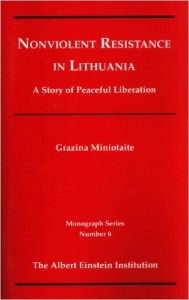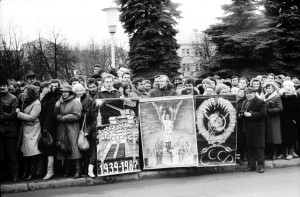Extrait de l’ouvrage: Grazina MINIOTAIT (1998), Nonviolent Resistance in Lithuania: A Story of Peaceful Liberation, The Albert Einstein Institution, Cambridge, MA; 86 p.
Pour consultez l’ouvrage complet, veuillez cliquer sur Nonviolent Resistance in Lithuania – A Story of Peaceful Liberation
 Lithuania was the first republic of the former Soviet Union to declare its independence. On March 11, 1990, a mere 1.5% of the Soviet population—inhabiting only 0.3% of Soviet territory—posed a fundamental challenge to the vast empire and its powerful apparatus of repression. The world had indeed noticed the challenge, though at first with little formal engagement yet plenty of (if at times condescending) sympathy. Only after the bloody events of January 1991 and the failed hard-line August 1991 putsch attempt did Lithuania receive widespread international recognition. On September 17, 1991, Lithuania was granted membership in the United Nations. Lithuania’s struggle, like those of Estonia and Latvia, exemplified the nonviolent way of East European liberation from the grip of totalitarian empire. Taken together, the scale of the last European nonviolent liberation movements can only be compared to India’s drive for independence, led by Mohandas Gandhi. Such liberation movements have clearly confirmed that there is an alternative to violent and military-driven social change. The attention of scholars has been drawn to nonviolent action as an effective, nondestructive type of “weapons system.” Gandhi was among the first national leaders to show both in theoretical analysis and practical action that nonviolent struggle is a positive force that can be successfully used in conflict. He was convinced that nonviolent action provided means of action incomparably superior to those of violence. Gandhi had noted that rulers and the ruled are ultimately bound by a relationship of partnership and mutual dependence rather than by one of force: “In politics, [the use of nonviolent action] is based upon the immutable maxim that government of the people is possible only so long as they consent either consciously or unconsciously to be governed.” The proposition can be held as the axiom of the theory of nonviolent action. This is of course not something entirely new. The idea was clearly stated by the sixteenth century writer Étienne de la Boetie, and later by Locke, Montesquieu and other classical representatives of political liberalism. Yet with Gandhi we see this axiom applied on a nearly unimaginable scale for national liberation.
Lithuania was the first republic of the former Soviet Union to declare its independence. On March 11, 1990, a mere 1.5% of the Soviet population—inhabiting only 0.3% of Soviet territory—posed a fundamental challenge to the vast empire and its powerful apparatus of repression. The world had indeed noticed the challenge, though at first with little formal engagement yet plenty of (if at times condescending) sympathy. Only after the bloody events of January 1991 and the failed hard-line August 1991 putsch attempt did Lithuania receive widespread international recognition. On September 17, 1991, Lithuania was granted membership in the United Nations. Lithuania’s struggle, like those of Estonia and Latvia, exemplified the nonviolent way of East European liberation from the grip of totalitarian empire. Taken together, the scale of the last European nonviolent liberation movements can only be compared to India’s drive for independence, led by Mohandas Gandhi. Such liberation movements have clearly confirmed that there is an alternative to violent and military-driven social change. The attention of scholars has been drawn to nonviolent action as an effective, nondestructive type of “weapons system.” Gandhi was among the first national leaders to show both in theoretical analysis and practical action that nonviolent struggle is a positive force that can be successfully used in conflict. He was convinced that nonviolent action provided means of action incomparably superior to those of violence. Gandhi had noted that rulers and the ruled are ultimately bound by a relationship of partnership and mutual dependence rather than by one of force: “In politics, [the use of nonviolent action] is based upon the immutable maxim that government of the people is possible only so long as they consent either consciously or unconsciously to be governed.” The proposition can be held as the axiom of the theory of nonviolent action. This is of course not something entirely new. The idea was clearly stated by the sixteenth century writer Étienne de la Boetie, and later by Locke, Montesquieu and other classical representatives of political liberalism. Yet with Gandhi we see this axiom applied on a nearly unimaginable scale for national liberation.

Historical studies of the development and dynamics of nonviolent action can offer unique insights into this form of social, economic, and political power. The present essay is an overview of nonviolent resistance in Lithuania in the nineteenth and twentieth centuries. Beginning with the story of Lithuanian resistance to Tsarist Russification, an attempt is made to show that the nonviolent character of the resistance was of major importance in defeating the Tsar’s policies.
The second chapter is a short account of the struggle for the preservation of national identity and values during the Soviet occupation from 1940 up to 1987. Chapters three and four analyze the emergence and actions of the independence movement after 1987, from early discussions by intellectuals to the mass liberation movement known as “Sajudis” (meaning “co-movement” in Lithuanian). Chapter five, comprising the period from the March 1990 declaration of independence to the bloody events of January 1991, describes the development of “people power” from spontaneous protest to such a level of organized nonviolent action that it directed the course of political events. From the January 1991 Soviet assault to the attempted hard-line Soviet coup in August 1991, Lithuanian defense policy developed mainly along the lines of “civilian-based defense.” This and the subsequent incorporation of nonviolent action into Lithuanian defense policies are looked at in chapter six. The appendices provide documentation, some for the first time in English, of these developments. This monograph seeks to highlight the important role that nonviolent action has played in Lithuania, especially in the reassertion of independence in the 1980s and 1990s. In no way is it my intention to try to revise or to downplay the troubling, and at times horrific, infliction of violence in Lithuanian history, particularly in regards to the destruction of the Lithuanian Jewish community during the Second World War. Rather, I seek only to draw attention to an often ignored strand of the Lithuanian experience, one that—given greater understanding and development—could help diminish the prospect of a recurrence of such destructive national and communal violence.
